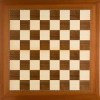Sorry, I just realized I never got around to posting the link to the new Problem of the Week. I've generally been impressed with the comments that have been left on previous POTWs, so hopefully folks will find this one interesting as well. I think it's a little bit easier than the last two, but you do have to look at it the right way. Good luck!
More like this
I have now posted the final POTW for the semester. That's right! After this, there will no more POTWs until September. So go have a look, and tell me what you think.
The fifth Problem of the Week has now been posted. This one is probably my favorite of the term. I think it's fairly challenging. It will have to hold you for a while, though, since POTW will be taking next week off.
My trip to New York was a lot of fun. Some friends from Kentucky were visiting me this weekend, and that was fun too. But in all the chaos Sunday Chess Problem ended up taking the week off. Sorry about that! It will return next week.
Spring break has ended. It is a great sadness. But that means that POTW can now return! Life is full of tradeoffs.

Talk about a red herring! ;)
I think I have this one, but it did take me a while to see it. Let A, B, C and D be the verticies of the quadrilateral. Let E be the point on AB tangent to the inscribed circle. Let F, G, and H be the tangent points on BC, CD, and DA respectively. Let O be the center of the circle.
Now draw the radii OE and OH. That forms triangles OEA and OHA. These triangles are congruent because they are right triangles (tangent to a circle is perpendicular to its radius), OE=OH and the hypotenuse OA is common to both. Therefore, AE = AH. In similar fashion, it can be shown that BE=BF, CF = CG, and DG=DH.
Now, some algebra. Let AB=4, BC=9, CD=16 (in keeping with the problem statement), and let AD=x. Adding equations from the previous paragraph gives BF+CF=BE+CG, but BF+CF = BC=9, so BE+CG=9. Proceeding further, DH+9 = BE+CG+DG, but CG+DG=CD=16, so DH+9=BE+16. Continuing, AH+DH+9=AE+BE+16. AE+BE=AB=4, and AH+DH=AD=x, so x+9=16+4, which easily solves to x=11.
Sean T, you just discovered the Pitot theorem, which follows directly from the fact that two nonparallel tangent lines to the circle meet at a point equidistant from the tangent points. 11 is the right answer.
But yeah, talk about a red herring indeed! What comes next after 4, 9, 16 ...?
I drew a picture, of course, and within 10 seconds, I knew by intuition that the total length of two opposite sides was equal to the total length of the other two sides. It turned out to be true after working through basically the same reasoning as the other comments, but it was strange how the idea popped into my head so quickly. I don't know if it was a long-buried memory of something I worked out in grade school, or a subconscious insight.
jrosenhouse wrote (March 23, 2015):
> […] the link to the new Problem of the Week
and there ( http://educ.jmu.edu/~rosenhjd/POTW/Spring15/POTW8S15.pdf )
> a cyclic quadrilateral […] then draw the two diagonals […] draw the incircles of the four triangles […] Those four centers from the vertices of a rectangle. It works every time!
Nice. Is it known who first proved this?
> That’s enough of that. Here’s this week’s problem:
A quadrilateral which has an inscribed circle has three consecutive sides of length 4, 9 and
16 respectively. Find the length of the fourth side.
That's a nice problem, too; especially because the described quadrilateral is not required to be plane (as long as it is understood that its four sides are all tangent to a straight cylinder which envelopes the inscribed circle).